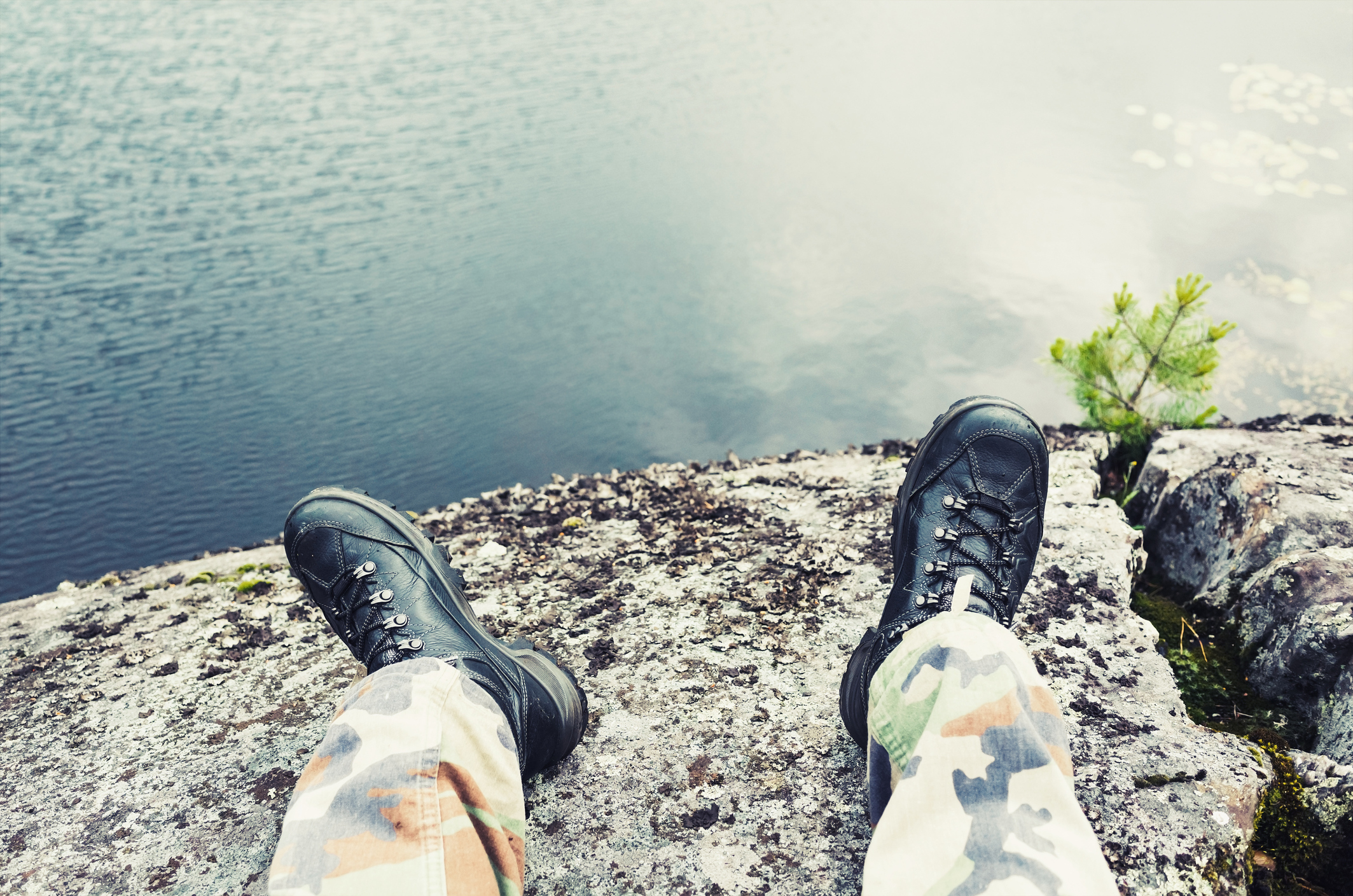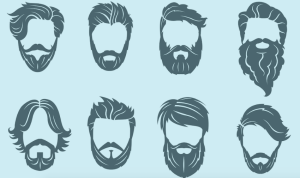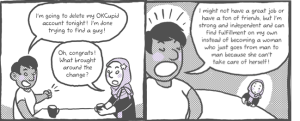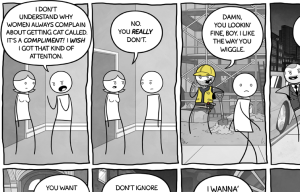
Two legs in camouflage pants and black boots, sitting near a body of water.
Editors’ Note: We at Everyday Feminism would like to note that this piece is not intended to dictate what people should or shouldn’t wear. It’s meant to simply give a pause for readers to think more carefully about seemingly innocuous fashion choices and the historical meanings behind them. As the headline states, the choice to wear military camouflage clothing “can” be anti-feminist — this is not meant to be read in absolutes or be a blanketing statement that applies to every situation or context. In this piece, the author offers just one perspective on this issue.
Being feminist means more than just organizing under the singular goal of “smashing the patriarchy.”
It also means understanding and acknowledging the ways that race, class, gender, sexuality, age, ability, global location, and citizenship or national identity affect how patriarchy impacts each of us differently.
As a white, cisgender, queer woman with US citizenship, the impacts of patriarchy on my daily life are drastically different from the impacts it has on the lives of black and brown folks in this country, on the lives of gender non-conforming folks, and on the lives of people in other parts of the world navigating the consequences of globalization, US imperialism, and Western capitalism.
And in order to be effective in our struggle, we must always be aware of these intersections and nuances. We must always look past our own immediate experiences of injustice, especially when fighting a system of oppression as far-reaching and diabolical as patriarchy!
This means not only showing up at your local Women Take Back the Night rally, but also committing to advocate against imperialist campaigns, acts of colonial violence, and military occupations of any kind.
But let’s take the conversation a step further: organizing from a feminist perspective that truly upholds the sentiment that “no one is free while others are oppressed,” means also opposing borders, the police state, and institutionalized racism in all of its forms.
For every woman in this country with US citizenship who has experienced the frustrating limitations of glass ceiling pay wages, a dozen Oaxacan women trying to cross the US-Mexico border are being detained and assaulted by border guards.
For every white woman who gets passed up for a promotion by a less qualified male co-worker, a dozen black women sit in cars with their families being held at gunpoint by racist highway patrol officers.
For every non-Arab woman subjected to an unnecessary pat-down at the airport by a male TSA agent, a dozen Muslim women are refused entry onto their flights because of other passengers’ complaints about feeling unsafe sharing an aircraft with certain racialized identities.
And that doesn’t mean you need to pick fights with tea party members or tell every airport TSA agent just exactly where they can shove that metal-detector wand (though I don’t necessarily discourage these acts of resistance either). You can also manifest these convictions in your daily choices – from the political organizing you do, to the articles of clothing you do or don’t choose to wear.
Personally, I feel that not wearing things that represent an affinity with the people carrying out these acts of violence is crucial.
It’s no secret: Our individual fashion choices communicate a lot about us – both intentionally and unintentionally – from our gender identities and class backgrounds, to our personal beliefs and subcultural affiliations.
Our personal fashion choices also affect the people around us deeply – both intentionally and unintentionally as well.
For every style-signifier that’s recognized and interpreted correctly, there are dozens of rapid-fire misinterpretations being silently catalogued in the minds of those around us all of the time.
It can feel nearly impossible to anticipate the reactions that any given person might have to our personal aesthetics. But in situations where we do have enough information to anticipate certain reactions – and especially trauma responses – we have a responsibility to be thoughtful, intentional, and accountable for the messages we’re non-verbally communicating.
There have been a lot of really important conversations about cultural appropriation in recent years, particularly in the realm of white people hijacking the cultural trappings of marginalized communities in contemporary fashion trends.
But the concept of cultural appropriation is much more expansive than this.
I’ve been having lots of conversations lately about one major iconic fashion trend that just won’t seem to die: the appropriation of military apparel – namely, camouflage patterned clothing.
I remember first seeing this civilian fashion trend in countercultural spaces (like in grunge and punk scenes) throughout the ‘80s and early ‘90s: the loose fitting, military-style camo jacket fashionably sliding off of one shoulder, or the baggy camouflage cargo pants cuffed sloppily at the bottom with safety pins.
In this context, wearing camouflage took a sort of antagonistic, antiauthoritarian stance that said, “I will fight for my convictions. I am tough, and you don’t want to fuck with me.”
And, I mean, it also kind of said “I don’t give a shit what I look like, but this is what Kurt Cobain and Eddie Vedder are wearing right now, so fuck you.”
But nowadays, wearing camouflage is no longer a trend associated with grunge or punk subcultures, hipster irony, or direct military combat.
In 2001, during the US invasion of Afghanistan, camo-patterned clothing made a grand entrance onto the mainstream fashion scene. Recently, Marc Jacobs, Juicy Couture, Calvin Klein and some big mass-manufacturers like Old Navy, have started producing clothing lines that feature different interpretations on camouflage.
But let’s have a conversation about the basic origin of camouflage, shall we?
Camouflage is a dye pattern that was initially made to disguise the bodies of soldiers during combat, so that they could stealthily hunt people on opposing armies. Let me repeat this: Camo patterns were made for the purpose of human hunting.
They were designed in order to afford soldiers with the maximum amount of protection while literally gunning down and killing other human beings. In the spirit of feminism, let us not forget our most basic goal: to create and sustain a world in which people inherently value, revere, and actively support each other’s survival.
If you ask me, this original intent can never be separated from our versions of contemporary camo-style fashion, no matter how eccentric it gets.
So with all this said, here are some tangible examples of how the appropriation of military apparel can cause harm and explicitly undermine our big-picture intentions as feminists – as people who recognize the intersectional relationships between patriarchy, race, class, gender, citizenship, and national identity.
While discussions about fashion may seem like a far throw from the kinds of issues we’re used to confronting as activists, being cognizant of the nonverbal narratives we do or don’t support when navigating our bodies through this world is actually important.
1. Border Guards
When I was a teenager, I had a close friend who came from a family of Mexican migrant workers.
I remember going over to her house one day wearing my usual, unkempt uniform of baggy, camo-patterned cargo shorts, an obscure band t-shirt, and an angst-ridden scowl that could wilt flowers.
As I entered the house, my friend’s little sister– an adorable, rosy-cheeked five-year-old who was standing in the kitchen – saw me come in. Her eyes grew wide with terror, she screamed, and then immediately ran to cower behind her mother’s leg.
This reaction threw me off. I mean, I was used to people staring at my weird outfits and occasionally making snide comments about the fact that I “looked like a punk,” but my presence had never evoked quite this response – especially from children.
My friend grabbed my hand and immediately led me into another room. She explained to me that her little sister probably had that reaction due to the violence she had to witness every time their family crossed the US-Mexico border.
She reminded me that US border guards are often armed white folks dressed in full military fatigues, the purpose of which is not to camouflage themselves, but to instill a sense of fear and subordination into those attempting to cross.
She went on to say that the boarder guards at this particular entry point were notorious for using unnecessary force and overt, physical violence on every brown person they interacted with, whether or not they were thought to be entering or exiting the country legally.
So basically, this child had witnessed her mother being harassed and her father being roughed up by white border guards wearing camouflage any time they’d tried to cross the border into Mexico to visit grandma.
And now, some random white girl in camouflage just strolled into her home – and understandably, she was terrified.
After this incident I became much more aware of the implicit harm my whiteness symbolized, but also, the way that harm was amplified by my choice to wear camo print.
2. Katrina Aftermath
A dear friend who moved up to Oakland from New Orleans after Hurricane Katrina recently told me about her experience of the storm’s aftermath.
She remembers after the flood hit, private security forces, thousands of local state and federal law enforcement officers, and armed, active duty soldiers from the National Guard showed up and started patrolling the city.
Needless to say, these troops weren’t there to provide aid. They were sent to establish military order and authority over a newly displaced community – the majority made up of low-income black folks.
I will never forget reading a quote that month from Jeremy Scahill, a reporter from The Nation: “[T]hese troops [in New Orleans] are armed as they would be in Iraq, with automatic rifles, guns strapped to legs, and pockets overflowing with ammo.”
And guess what else.
Many of them were fully suited in camouflage.
Residents of this community – a community navigating the impacts of a major life-altering disaster – were being flippantly shot and killed by a militarized police force over allegations of looting.
My friend says she remembers watching members of her family being treated like criminals, their very lives threatened by men in camouflage uniforms daily.
Due to the residual trauma that still lives in her body, my friend says she can’t see a camouflage pattern without literally feeling sick to her stomach.
3. Militarized Police Force in Ferguson
One final example of the violence we condone when we wear camo-patterned clothing is the militarized police force we witnessed happening in Ferguson after the murder of Michael Brown.
When local communities began organizing and protesting against the shooting of an unarmed black man by a state police officer, the police force reacted by deploying military-grade gear and force.
At that time, it was difficult to distinguish photos of police in Ferguson from images coming out of war zones like Iraq and Afghanistan. Armored vehicles driven by officers (dressed in full camouflage battle uniforms) patrolled the streets at all hours.
One citizen’s account documented in the Riverfront Times noted that Ferguson’s militarized police force even shot gas canisters at protesters who were standing peacefully in their own back yards.
The Cato at Liberty quoted another citizen – a man who’d identified himself as an 82nd Airborne Army veteran – as saying, “We rolled lighter than that in an actual warzone.”
In response to these events, even President Obama endorsed a new law banning US law enforcement from using military grade equipment and from wearing most camouflage uniforms.
The sentiment behind this law was that the presence of military weapons and apparel were used to instill fear into the lives of innocent (mostly black) civilians.
***
I’ll say it again: As feminists, it’s important that we oppose imperialist war, colonial violence, and military occupations of any kind.
As feminists, it’s important that we oppose borders, the police state, and all forms of institutionalized racism.
So despite what’s chic in contemporary fashion these days, we should honor our politics and think deeply about the representations we embody when appropriating military apparel.
[do_widget id=’text-101′]
Annah Anti-Palindrome is a Contributing Writer for Everyday Feminism. She is a bay-area based writer, musician and queer/femme antagonist who hails from the working-class craters at the base of the Sierra Foothills. For more info on her work, see annahantipalindrome.com. To contact, message her via her facebook fan page!
Search our 3000+ articles!
Read our articles about:
Our online racial justice training
Used by hundreds of universities, non-profits, and businesses.
Click to learn more




















